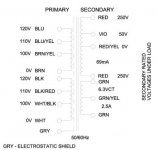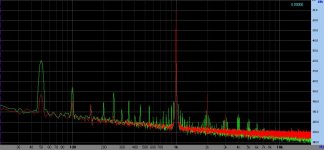Better pot
As the use of an Alps Blue velvet was considered a few posts above - here is a far better alternative:
SMT Resistor Step Attenuator 100K Volume Control | eBay
In comparison to a Slage Autoformer both were head to head in clarity.
Blue Velvet pot muddies your signal.
As the use of an Alps Blue velvet was considered a few posts above - here is a far better alternative:
SMT Resistor Step Attenuator 100K Volume Control | eBay
In comparison to a Slage Autoformer both were head to head in clarity.
Blue Velvet pot muddies your signal.
I have found in the past that centering the image improved the stage depth.Why?
IMHO balance is totally unnecessary. Completely uninteresting that sweet spot is in the "middle", or need to sit other position in the sofa.
Hi Andy,
I would like to follow your recent schematic (with 126C plate load) for building 26 preamp and I have CX380 on hand.
Would you mind to share the current PSU schematic with me.
Can I use 100H 10ma choke for alternative of 126C ?
Beside, how to get the value of 14.5R 30w resistor.
Thank you
I would like to follow your recent schematic (with 126C plate load) for building 26 preamp and I have CX380 on hand.
Would you mind to share the current PSU schematic with me.
Can I use 100H 10ma choke for alternative of 126C ?
Beside, how to get the value of 14.5R 30w resistor.
Thank you
Well, my most recent preamp was a 10Y with 2 x Hammond 126C interstages in series, just used as plate chokes with Russian teflon FT-2 output caps. It sounds great.
But it has a competitor now - I just built a 26 preamp with a single 126C as plate choke with FT-2 coupling cap. You may have gathered by now that I like the 126C a lot as a plate choke. I think I must have tried this setup as long as 8 years ago, but it's come up fresh and very nice this time. I run it at maximum for the 26 according to the data sheet to get the Ra down and give me as much current as possible to drive my 4P1L PSE output stage. OPT this time is O'Netics and I'm enjoying the sound a lot - it's full and warm yet still detailed. It's staying in my system for now - the 26 magic has come back.
It's a cheap build - 26 are plentiful and the Hammond 126C is very economical for what it is - a good bifilar wound transformer. You get 1:1 so no step-down. It needs to go straight in to the following stage, which in my case it does fine.
Hi Andy,
I would like to follow your recent schematic (with 126C plate load) for building 26 preamp and I have CX380 on hand.
Would you mind to share the current PSU schematic with me.
Can I use 100H 10ma choke for alternative of 126C ?
Beside, how to get the value of 14.5R 30w resistor.
Thank you
I haven't quite finalised the 2 x 126C option, still experimenting. I'm a little down in the treble right now so need to try different wirings and topologies. 100H at 10mA is a good start, and 200H probably better as long as the DCR isn't silly. For cathode resistors go for wire wound vitreous enamel or Russian ex-military. I leave you to work out the PSU - plenty of choices, as long as the capacitors are polypropylene like motor run etc. I like choke input filament supplies - Hammond are fine, and you'll want a 1.5amp or more.
I've tried out Audio Note Kaisei electrolytics in my 26 preamp. They are truly excellent. Better in every way than Solen polypropylene in the power supply.
So you don't HAVE to use polypropylene to get good results. Or Solen sucks big time.
So you don't HAVE to use polypropylene to get good results. Or Solen sucks big time.
I've tried out Audio Note Kaisei electrolytics in my 26 preamp. They are truly excellent. Better in every way than Solen polypropylene in the power supply. So you don't HAVE to use polypropylene to get good results. Or Solen sucks big time.
OK - I haven't tried those. In my experience polypropylenes beat cooking grade electrolytics every time, but who knows what exotic parts can do. Thanks for that.
Alright, I have an EE question. I hooked up the both primary coils of my Hammond 369JX to 120V in parallel, and on the secondaries I put a multimeter on the 250-0-250v coil and left the 5V coil open. When I added power, I blew the fuse in my IEC inlet. Why is this, did i make a wiring mistake?
Hi Andy,
Thank you for your recommendation.
I will try to order a Power transformer 290v-250v-0 and 100H 10ma choke from China. it may a good start for my project.
For cathode resistors, I still have no idea to get a better one for 30w.
🙂🙂
Thank you for your recommendation.
I will try to order a Power transformer 290v-250v-0 and 100H 10ma choke from China. it may a good start for my project.
For cathode resistors, I still have no idea to get a better one for 30w.
🙂🙂
I haven't quite finalised the 2 x 126C option, still experimenting. I'm a little down in the treble right now so need to try different wirings and topologies. 100H at 10mA is a good start, and 200H probably better as long as the DCR isn't silly. For cathode resistors go for wire wound vitreous enamel or Russian ex-military. I leave you to work out the PSU - plenty of choices, as long as the capacitors are polypropylene like motor run etc. I like choke input filament supplies - Hammond are fine, and you'll want a 1.5amp or more.
I hooked up the both primary coils of my Hammond 369JX to 120V in parallel
Are you sure that use this wiring in primary?
BLU-BLK 120VAC
BRN-WHT 0VAC
I have Brown and Black hooked up to Neutral from wall, and White and blue hooked up to Line from the wall. This shouldn’t matter, though, right?
This is cross connected wiring. :-(I have Brown and Black hooked up to Neutral from wall, and White and blue hooked up to Line from the wall. This shouldn’t matter, though, right?
one coil: BLU..BRN
other: BLK...WHT
Attachments
I've tried starved filaments (850mA) vs. (almost) non-starved (990mA) on my 26 preamp and to me it's quite obvious that non-starved sounds better. Fuller, rounder, more focused and 3-dimentional midrange. Is this something others have experienced or is it just related to a lower plate resistance and my use of transformers?
I don't understand why its so hard to make these tubes quiet....they were designed for AC heating and no mention of micro-phony....what are we missing here? if these were so bad back in there day why were or how could be used?
Lawrence
Lawrence
I have few dozens of #26 tubes, mostly globe ones.
None of them has -listenable- microphony (am I lucky?), but they are more or less sensitive of radiated noise (hum, radio stations, cellular phones etc.).
These tubes are in great-great-grandfather's age, so it's internal stucture - especially heater/cathode - is "open", therefore unprotected against electro smog.
None of them has -listenable- microphony (am I lucky?), but they are more or less sensitive of radiated noise (hum, radio stations, cellular phones etc.).
These tubes are in great-great-grandfather's age, so it's internal stucture - especially heater/cathode - is "open", therefore unprotected against electro smog.
I have few dozens of #26 tubes, mostly globe ones.
None of them has -listenable- microphony (am I lucky?), but they are more or less sensitive of radiated noise (hum, radio stations, cellular phones etc.).
These tubes are in great-great-grandfather's age, so it's internal stucture - especially heater/cathode - is "open", therefore unprotected against electro smog.
ok...but still these tubes were used well into the 40's with plenty of RF in the air! something else is going on.....



I don't understand why its so hard to make these tubes quiet....they were designed for AC heating and no mention of micro-phony....what are we missing here? if these were so bad back in there day why were or how could be used?
Lawrence
They were designed for battery heating.
They were designed for battery heating.
Well thats interesting....where can you buy hi AH 1.5 volt battery LOL
They were designed for battery heating.
but this is NOT correct...it says RIGHT in the tube data AC heating!
- Home
- Amplifiers
- Tubes / Valves
- #26 pre amp

